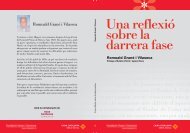El retorn de la llúdriga - Fundació Catalunya - La Pedrera
El retorn de la llúdriga - Fundació Catalunya - La Pedrera
El retorn de la llúdriga - Fundació Catalunya - La Pedrera
Create successful ePaper yourself
Turn your PDF publications into a flip-book with our unique Google optimized e-Paper software.
5.5.5. I<strong>de</strong>ntificació genètica <strong>de</strong>ls individus<br />
L’objectiu d’aquest estudi és po<strong>de</strong>r i<strong>de</strong>ntificar individualment els animals<br />
presents a l’àrea <strong>de</strong> reintroducció, siguin alliberats o ja nascuts en llibertat.<br />
S’utilitzen marcadors molecu<strong>la</strong>rs d’ADN, preferentment proce<strong>de</strong>nts d’ADN<br />
nuclear, anomenats marcadors microsatèl·lit. Amb aquests marcadors es pot<br />
conèixer el patró d’al·lels <strong>de</strong> cada individu i, així, establir quants individus,<br />
com a mínim, estan presents en <strong>la</strong> zona mostrejada, <strong>la</strong> seva distribució<br />
geogràfica i l’evolució <strong>de</strong> <strong>la</strong> pob<strong>la</strong>ció. L’estudi <strong>de</strong> les freqüències al·lèliques<br />
<strong>de</strong> <strong>la</strong> pob<strong>la</strong>ció i <strong>la</strong> variació d’aquestes freqüències en estudis posteriors, indicaran<br />
<strong>la</strong> progressió <strong>de</strong> <strong>la</strong> pob<strong>la</strong>ció en el temps. Es van seleccionar 10 marcadors<br />
adients per estudiar pob<strong>la</strong>cions ibèriques.<br />
Microsatèl·lits i genotips<br />
<strong>El</strong>s microsatèl·lits són seqüències d’ADN repetitives <strong>de</strong> 2 a 6 parells <strong>de</strong> bases<br />
distribuï<strong>de</strong>s per tot l’ADN nuclear.Aquestes seqüències d’ADN es segreguen<br />
<strong>de</strong> forma men<strong>de</strong>liana, és a dir, cada individu rep una còpia (o al·lel) <strong>de</strong> <strong>la</strong> mare<br />
i una còpia <strong>de</strong>l pare (figura 5.24). <strong>El</strong>s microsatèl·lits<br />
po<strong>de</strong>n variar molt <strong>de</strong> l<strong>la</strong>rgada, i existir diferents tipus<br />
d’al·lels en una pob<strong>la</strong>ció per a cada microsatèl·lit (figura<br />
5.25). Un individu pot heretar <strong>de</strong>ls seus progenitors<br />
dues còpies idèntiques (homozigot) o rebre dues<br />
còpies diferents (heterozigot).<br />
L’estudi <strong>de</strong> l’ADN <strong>de</strong>ls animals amb diferents marcadors<br />
microsatèl·lit permet establir un perfil genètic<br />
(genotip) característic i únic <strong>de</strong> cada individu,<br />
segons <strong>la</strong> combinació d’al·lels que presenta en el conjunt<br />
<strong>de</strong> marcadors microsatèl·lit.<br />
A<br />
B<br />
C<br />
Marcador 1 Marcador 2<br />
122<br />
122<br />
122<br />
Cromosomes<br />
paterns<br />
Variant<br />
al·lèlica A<br />
<strong>de</strong>l microsatèl·lit<br />
Homozigot<br />
AA<br />
Homozigot<br />
AB<br />
Va caldre optimitzar el mèto<strong>de</strong> per l’extracció d’ADN a partir d’excrements<br />
<strong>de</strong> <strong>llúdriga</strong> i, <strong>de</strong>sprés <strong>de</strong> diverses proves, s’ha aconseguit aïl<strong>la</strong>r, amplificar,<br />
obtenir els genotips per marcadors microsatèl·lit i seqüenciar amb èxit<br />
ADN a partir d’aquestes mostres. <strong>El</strong>s treballs <strong>de</strong> <strong>la</strong>boratori es realitzen actualment<br />
per l’Ainhoa Ferrando a <strong>la</strong> Unitat <strong>de</strong> Genètica <strong>de</strong> Conservació <strong>de</strong> l’Institut<br />
<strong>de</strong> Recerca i Tecnologia Agroalimentàries (IRTA) <strong>de</strong> <strong>la</strong> Generalitat <strong>de</strong><br />
<strong>Catalunya</strong>.<br />
Es van estudiar els genotips <strong>de</strong> 25 llúdrigues reintroduï<strong>de</strong>s ja que, ma<strong>la</strong>uradament,<br />
no es va po<strong>de</strong>r disposar <strong>de</strong> mostres <strong>de</strong>ls 41 exemp<strong>la</strong>rs alliberats.<br />
A<br />
189 197<br />
185 189<br />
197<br />
Cromosomes<br />
materns<br />
Variant<br />
al·lèlica B<br />
<strong>de</strong>l microsatèl·lit<br />
Homozigot<br />
BB<br />
4000<br />
3000<br />
2000<br />
1000<br />
3000<br />
2000<br />
1000<br />
4000<br />
3000<br />
2000<br />
1000<br />
<strong>El</strong> <strong>retorn</strong> <strong>de</strong> <strong>la</strong> <strong>llúdriga</strong> 65<br />
B<br />
MP P M D<br />
Figura 5.24. A) Esquema <strong>de</strong> l’herència <strong>de</strong>ls<br />
al·lels materns i paterns en un individu. B)<br />
Lectura <strong>de</strong> <strong>la</strong> mida <strong>de</strong>ls fragments amplificats<br />
amb un marcador microsatèl·lit. Si un individu<br />
posseeix dues còpies idèntiques, només s’aprecia<br />
una banda <strong>de</strong>l fragment amplificat, mentre que<br />
si les dues còpies tenen una mida diferent,<br />
corresponent a un número diferent <strong>de</strong><br />
repeticions <strong>de</strong>l microsatèl·lit, apareixen dues<br />
ban<strong>de</strong>s. MP = marcador <strong>de</strong> pes molecu<strong>la</strong>r,<br />
P = pare, M = mare, D = <strong>de</strong>scen<strong>de</strong>nt.<br />
Figura 5.25. Al·lels <strong>de</strong> tres individus A, B i C<br />
genotipats amb dos marcadors microsatèl·lit,<br />
analitzats amb el programa d’un seqüenciador<br />
automàtic. <strong>El</strong>s tres individus tenen el mateix patró<br />
per al marcador 1 i són homozigots per l’al·lel<br />
122. <strong>El</strong> marcado 2, en canvi, presenta un patró<br />
diferent en cada cas. <strong>La</strong> combinació diferent <strong>de</strong>ls<br />
al·lels 185, 189 i 19 en heterozigosi (A i B) o en<br />
homozigosi (C), ens permet diferenciar-los. Com<br />
més marcadors afegim, més probabilitats tindrem<br />
<strong>de</strong> diferenciar els individus entre sí.




